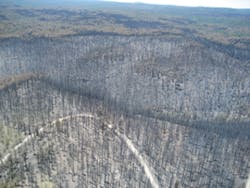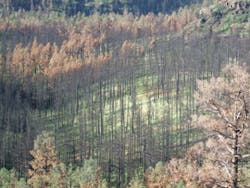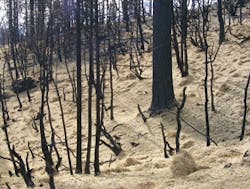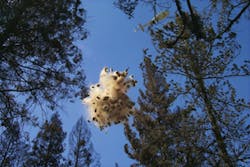Thousands of American acres, both private and public, burn each year. Whether caused by human carelessness or malevolence, or natural causes such as lightning strikes, wildfires destroy natural resources, displace wildlife, and often put human lives at risk. Because of its dry climate, the Southwest’s forested areas are especially vulnerable to seasonal fires.
While wildfires destroy, they also create; some plant species, such as Ceanothus (shrubs and trees in the buckthorn family), require high temperatures to spur germination of seeds. As such, fire is part of the natural cycle of a forest’s death and rebirth; dead or dying trees and thick underbrush are burned away, allowing smaller trees direct access to sunlight and soil space. In some parts of the nation, “rainy season” follows “fire season,” and the new plants quickly begin to thrive.
This cycle, which has repeated for millennia, was not considered a problem until humans were injected into the equation. When fire destroyed an area, ruining fruit trees and crops and scattering huntable wildlife, early humans had no choice but to move. In modern times, humans don’t want to give up their scenic homes, which are often nestled on the outskirts of national forests. Also, with water at a premium, it’s important to keep sources clean of the silt and debris washed down off treeless hillsides.
The BAER Necessities
From her US Forest Service office in Albuquerque, NM, which supervises the Apache-Sitgreaves National Forest, BAER national coordinator Penny Luehring explains the Burned Area Emergency Response (BAER) team and describes the process of post-fire remediation: “BAER teams are interdepartmental. All federal land management agencies-the Forest Service, Bureau of Land Management, National Park Service, US Fish and Wildlife Service, and Bureau of Indian Affairs-have similar programs. The oversight group is at the national level; its goal is to keep BAER policies and procedures as similar as we can among the various agencies.”
Six weeks after the fire, results and regrowth were evident. The seedlings are a one-season cereal grain, which shelters native plants but does not overtake them.
A certain amount of planning, such as determining BAER team members for an area, is done in advance. “We try to keep teams as local as we can, because those folks who live and work in the area know it best,” she says. “BAER assessment teams are, for the most part, pulled from federal agencies, but we give responsibility to the local staffers.”
BAER teams have two basic purposes: minimize threats to life and property, and prevent unacceptable resource damage. “Resources” range from natural resources such as lakes, streams, and reservoirs to manmade structures such as roads, bridges, ranger stations, and lodges or developed camping sites. “As FEMA’s more “˜pubic assistance,’ we interact with that agency if there’s a natural disaster-a flood knows no boundaries,” Luehring says. “However, for wildfires, we work with the Natural Resources Conservation Service [NRCS] to reach our goals. BAER teams provide service for federal lands; NRCS serves the same purpose for private landowners through its Emergency Watershed Protection [EWP] program.”
The local forest supervisor makes the decision to call in the BAER team. “The eventual size of the team depends upon the resources at risk,” she explains. “The type of resources, their values, and the magnitude of potential risk is what determines if we propose treatments or take other actions. Most fires are assessed for post-fire risks, even those as small as 500 acres; it’s a site-by-site call. Many burned areas don’t experience “˜severe effects,’ which include large areas of high burn severity. BAER teams need to know what the threat is, and what’s on the site. For example, if contaminants are on the site, such as those often found in or near abandoned mines, extra care will need to be taken to ensure those contaminants don’t end up in local waters.”
Dispatching a team to a fire depends upon the fire’s size and locale. “In what part of the country is the fire located? Some people are more “˜used to fires,’ as dealing with them is annual occurrence in some parts of the country, such as the Southwest. There are BAER coordinators in every national forest, and they’re all prepared to deal with burned areas by keeping tabs on the people with the training and fitness requirements who can be called up to serve on such teams. BAER teams aren’t laypeople or volunteers; they’re resource specialists, with technical skills: hydrologists, soil scientists, wildlife biologists, archaeologists, engineers, vegetative specialists, and others. The only way to be successful is to plan ahead-not scramble at the time of a fire.”
The Wallow Fire
Named for the Bear Wallow Wilderness area where the fire originated, the 2011 Wallow wildfire burned nearly 841 square miles of Arizona and New Mexico, giving it the “distinction” of being the largest fire in Arizona’s recorded history. What likely began from a poorly tended campfire on May 29 resulted in miles of devastation, and the evacuation of thousands of people, before the fire was finally controlled on July 8. A slideshow from the website of KPNX-TV/The Arizona Republic dramatically illustrates the fire’s progression.
The fire was a monumental challenge for the BAER team. “We had a sinking feeling, watching the fire’s progression. Wallow was very unusual because it was so big,” Luehring sighs. “The area burned in June, and the rainy season arrived in July; we knew we’d be fighting something right around the corner. It’s common for people to think that when the fire’s out the crisis is over, they’re safe-but after a fire, the hill-slopes have nothing to hold the water when the rains come. The fire’s aftermath left the area vulnerable to water contamination and mudslides.”
With 841 square miles to worry about, the BAER team had to make choices. “They had to tackle post-fire work much like the doctors on M*A*S*H would when receiving a slew of casualties from the battle field-triage; focus on the ones most important and at risk.”
The fire demanded quick action; assessment was the first step. “The fire was still smoldering or burning when we got there. We can’t afford to wait until a fire is completely out,” Luehring says. “Of course, we pay attention to team members’ safety, so BAER teams start working at the cold end of the fire.”
Where to start? “In any fire, we have some remotely sensed information that will help us figure where to start and what to do,” she explains. “We compare vegetation from the LANDSAT satellite-see what’s burned, and what’s at risk. Such information focuses people on where they need to go on the ground. However, satellite information by itself is too general; we need to be there on the ground, to do field validation.
“The team does its assessment, finds risks to resources. For example, lots of flooding or erosion might be predicted. Team members propose treatment, which has to be approved at the federal funding level-but this process is very expedited, only taking a few days. Once the strategies and costs are approved, the team awards contracts for the actual work.”
As soon as an area is cool enough to work in, teams converge on the headwaters of each slope. “Cost-wise, it’s better to do something on the hill-slope, at the source, rather than try to control the water flow farther downstream,” Luehring says.
For such large projects, straw is the BMP of choice. “Straw mulching, using bales, is a more common BAER treatment than hydromulching or hydroseeding; only very high-value areas get those wet treatments. Also, hydromulch or hydroseed treatments do not work as well in areas with high intensity rainfall or heavy snow.”
Straw From the Sky
Solid straw bales are not used as “silt-breaks”; instead, the straw is sprinkled from the air. “Spreading straw by hand or by truck is just not
bombing,” resulting in a thick ground cover of straw.
fast enough. The straw mulch is dropped from a net carried by a helicopter. When it falls, it looks like little straw raindrops. Getting the straw on the ground at the right rate requires much skill by the helicopter operator; he must know how fast to fly, and at what altitude, to ensure that the straw falls on specific target areas. For the Wallow fire, there were three separate contracts for aerial mulching alone. In addition, pilots have to be careful to spread the straw only in cooled areas, so it doesn’t ignite.”
Higley, AZ’s Revegetation Services was one of the contractors for the Wallow fire. “We’ve been applying straw from the air for 15 years now,” says CEO Kurt Anderson. “We don’t get called in until the fire has been 90% contained. We provided the straw as part of the bid and basically tried to get all the straw we could find in Arizona. Getting the straw to spread evenly partly depends on the type of straw you get, and how long it’s been baled. If the straw went through a rotary combine, it will be short and break apart fairly easily. If it has been baled for over three or four months, or has been weathered, you have to cut the strings and break it apart a bit before spreading.”
Anderson’s firm uses helicopters to make straw drops. “The straw is in a net beneath the ‘copter. A good pilot knows the optimum heightKnowing where to deposit the straw comes from visual inspection as well as GPS coordinates. “We get the BAER team’s files with GPS coordinates on where to put the straw. We fly the area and look for the hot spots, which are where the fire burned hottest and needs the straw mulch the most. We don’t tint the straw; with the blackened hillsides, it’s easy to tell where straw has been dropped.”
How many acres could his firm cover in a day? “How far you are from your loading zone determines how many acres you can do. Plus, how much straw can be loaded in the nets. The higher the altitude, the less you carry. You have to calculate the altitude, as some jobs are done at 8,000 feet. At that height, you could carry about 1,800 pounds of straw if conditions allow. At a lower altitude you can carry more, maybe 2,400 pounds,” Anderson concludes.
Many parts of the nation were ablaze in 2011; how did contractors secure enough straw for the Wallow fire? “The fire occurred just right during straw production time. Crews were driving straw in from quite a distance, three and four states away. They were bailing it as fast as they could,” Luehring adds.
Other BMPs in the Toolbox
“Sometimes a wood shred is used, which offers instant ground protection and does what we need. In some areas seed is put down first, as well,” Luehring continues. “Contractors will use a fast-growing annual like a cereal grain, which doesn’t reseed itself, so it gets out of the way of native seeds when they sprout.
“Silt dams and wattles may also be in our toolbox,” she goes on, “as well as logs used like wattles for erosion barriers on hill-slopes. However, log and wattle erosion barriers have limitations. For the Wallow fire, it would’ve been almost laughable to try wattles or logs. Those take manpower, which means they’re very slow to implement. We’re always looking for the best thing we can get in the fastest amount of time.
“As for channel treatment, if we can be at the top of the watershed, in small tributary channels, we can install check dams using rocks, logs, or straw bales. However, this can be labor intensive, as well as having the potential to do more damage than value. If hill-slopes are not stable, it’s best to stay out of the channel.” Is erosion ever caused by water from firefighting? “No, firefighters put out fires by setting backfires-meaning, there’s no more fuel to allow the fire to spread-or by using an aerial retardant slurry.”
Minimizing erosion to campground areas requires the same treatment as on hillsides. “We also remove hazard trees-burned trees that might fall and hurt someone. To protect cultural resources such as petroglyphs or ancient pueblos, we might use localized erosion treatment. Unfortunately, we have to recognize that there’s no guarantee our efforts will work-for example, if there’s a severe thunderstorm, and a big “˜gully washer’ rushes through the area. In such cases, when human life or safety is at risk, the best action is to close off areas and roads and put up warning signs, communicating hazards to people who live downstream.
“BAER is just for time-critical stabilization and actions; later the Forest Service goes back and does more rehabilitation or restoration. Unfortunately, unlike for the BAER team, there’s no special funding for post-fire rehabilitation. Forest managers have to work that into their regular programs using regular agency funds. In many cases, one to 10 years later, people are still working to eliminate the after-effects of a fire.”
Statistics and Solutions
Luehring goes through the statistics of the Wallow Fire. “It started May 29, 2011. Assessment began on June 14, and on-the-ground treatment began on the 20th. There was no way we were going to send people into that inferno before then. The fire was controlled by July 8, and all the work was finished by August 17. Huge amounts of stuff went into the site: 81,000 acres were seeded, 34,000 acres were mulched. Hazard trees were removed along 45 miles of road, and drainage improvements were made along 200 miles of road. The other 400,000 acres were not deemed crucial. Not every acre gets treated. Maybe less than 10% of a wildfire site typically gets BAER treatment.”
In recent years, wildfires have seemed larger, more destructive; human intervention might have been the cause. “When fighting fires, the mindset for many years was “˜put out fires, let the brush grow.’ However, this has a worse long-term effect-leaving more things to grow means more fuel for fires. Due to the way nature works, there are times we need to let things burn. But now, as people have moved closer to these places, more life and property is at risk.
“At the time, the Forest Service had the best of intentions. But if we hadn’t fought fires all the past 100 years, which would have allowed the underbrush to die out, making less fuel for fire, we might not have these problems now. Adding to that, in the southwest, the winter of 2010 and 2011 was very dry, after a season of severe drought. Add to that high winds and the fire’s heat-Wallow became a “˜perfect fire.’ Yet Wallow also offered examples of the benefits of maintenance. Some places in there, where the area had been thinned out, the fire’s behavior was less intense. The benefits: This thinning allowed at least two communities to be saved.”
The Wallow fire was a learning experience, and the lessons are being passed on. “BAER teams provide information-sharing and education-no one has to discover better procedures for themselves. We’re also monitoring when we do treatment, looking specifically for results. Did the treatment do what we wanted it to do? If not, we’ll look for a better solution. Of course, this was a Southwestern fire; we’d definitely do things differently in another climate.”
With all the different treatments, the Wallow fire was the most expensive single fire BAER has handled, costing about $28 million. “But what damage would have been done if we hadn’t spent the money? There’s an economic analysis done ahead of any BAER treatments to show that benefits are worth the investments.” Were there any complaints from the budget-tightening Congress? “BAER is funded from the Forest Service’s firefighting fund, which traditionally has strong public and Congressional backing. We’re also very careful and cautious about spending those monies; we have an eye toward the expense. For example, is there any way to make some of that money back? Could we sell mulch? There are 500 acres of burned trees just standing there. We’ve looked into opportunities to make that into mulch, to use as stabilization treatments instead of purchasing straw.”
Current solutions aren’t perfect; what does the future hold?
“People in the erosion control business are looking into this, with thoughts of providing a better product. Some of these ideas are outside the box. If someone were to come up with a “˜magic liquid’ that holds the soil in place, we’d like to see how it works, but we can’t buy techniques that aren’t proven to be effective. We love new ideas, but we just can’t be experimenting with unproven methods at the time when we’re under the gun,” Luehring concludes.





